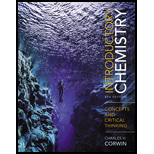
Concept explainers
Interpretation:
The physical property which distinguishes a lipid from a protein, carbohydrate and
Concept introduction:
A lipid is a compound which is made up of an alcohol and one or more carboxylic acids. Lipids are found in fats and vegetable oils. Fats and oil are formed by the esters of glycerol.
Answer to Problem 1CE
Lipids are insoluble in water, while protein,
Explanation of Solution
A lipid is a compound which is made up of an alcohol and one or more carboxylic acids. Lipids are found in fats and vegetable oils. Fats and oil are formed by the esters of glycerol. Fats and oils are insoluble in water; therefore, lipids are insoluble in water.
Proteins, carbohydrates and nucleic acid are water soluble compounds.
Therefore, a lipid differs from a protein, carbohydrate and nucleic acid by its insolubility in water.
A lipid is not soluble in water while protein, carboxylic acid and nucleic acid are water soluble compounds.
Want to see more full solutions like this?
Chapter 20 Solutions
Introductory Chemistry: Concepts and Critical Thinking Plus MasteringChemistry with eText -- Access Card Package
- What is the balanced equation for sugar, C12H22O11, breaks down to carbon and water when heated?arrow_forwardSilver ions are classified as a heavy metal, while sodium ions are not. Using this information, what do your results suggest about the stability of proteins in the presence of heavy metals?arrow_forward
 Chemistry: An Atoms First ApproachChemistryISBN:9781305079243Author:Steven S. Zumdahl, Susan A. ZumdahlPublisher:Cengage Learning
Chemistry: An Atoms First ApproachChemistryISBN:9781305079243Author:Steven S. Zumdahl, Susan A. ZumdahlPublisher:Cengage Learning ChemistryChemistryISBN:9781305957404Author:Steven S. Zumdahl, Susan A. Zumdahl, Donald J. DeCostePublisher:Cengage Learning
ChemistryChemistryISBN:9781305957404Author:Steven S. Zumdahl, Susan A. Zumdahl, Donald J. DeCostePublisher:Cengage Learning
- Chemistry: Matter and ChangeChemistryISBN:9780078746376Author:Dinah Zike, Laurel Dingrando, Nicholas Hainen, Cheryl WistromPublisher:Glencoe/McGraw-Hill School Pub Co
 World of Chemistry, 3rd editionChemistryISBN:9781133109655Author:Steven S. Zumdahl, Susan L. Zumdahl, Donald J. DeCostePublisher:Brooks / Cole / Cengage Learning
World of Chemistry, 3rd editionChemistryISBN:9781133109655Author:Steven S. Zumdahl, Susan L. Zumdahl, Donald J. DeCostePublisher:Brooks / Cole / Cengage Learning World of ChemistryChemistryISBN:9780618562763Author:Steven S. ZumdahlPublisher:Houghton Mifflin College Div
World of ChemistryChemistryISBN:9780618562763Author:Steven S. ZumdahlPublisher:Houghton Mifflin College Div





